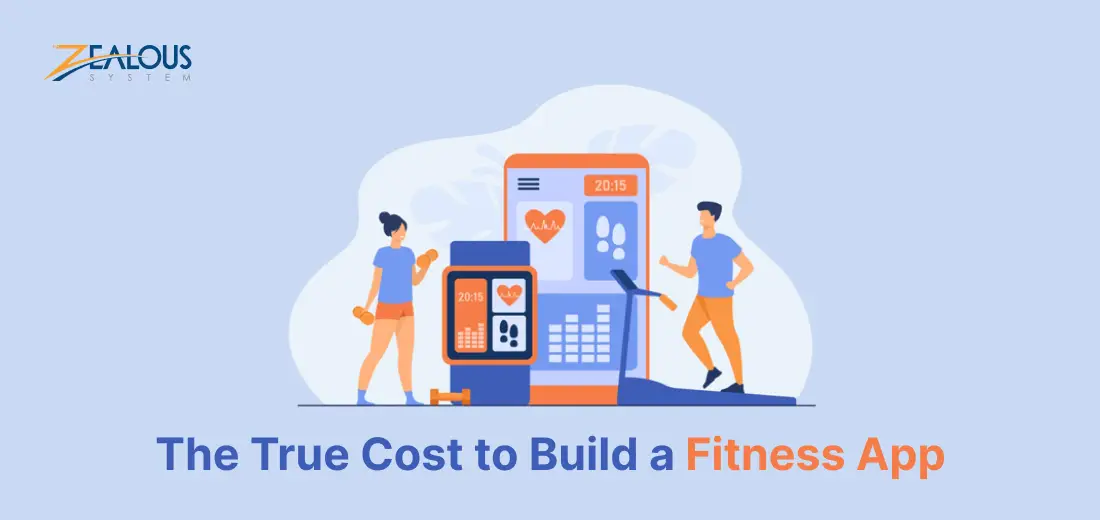
We use cookies and similar technologies that are necessary to operate the website. Additional cookies are used to perform analysis of website usage. please read our Privacy Policy
How Much Does It Cost To Build A Fitness App?

Fitness industry is booming, and mobile apps have become powerful tools to help you reach your health goals. But if you’re thinking about making your own fitness app, you’re probably wondering, “How much will it cost?” In this read, we’ll go through the world of fitness app development costs and much more. We’ll explore what factors can affect the price and give you some valuable tips to keep your budget in check and a lot more in this read.
But before we get into the nitty-gritty of fitness app costs, let’s first take a quick look at some interesting facts about the fitness industry. As per Researchandmarkets, with a market size projected to exceed USD 56.29 billion by 2030, it represents a potent opportunity for business executives in the tech and health sectors to capitalize on.
It’s not only thriving but also becoming increasingly dependent on mobile apps. So, whether you’re dreaming of creating your own fitness app or just curious about the financial side of it, you’re in the right place to learn how to bring your fitness app vision to life without breaking the bank.
Statistics and Market Share of Fitness Industry
So to begin with, let’s get the stats started. Here’s a chart that shows Fitness App Market Size, Share & Trends Analysis Report:
- As per another report from Grand View Research, health and fitness apps show the highest retention rates across all categories with 96.0% of users using only one of these apps.
- Millennials are considered the “wellness generation,” with 79% of Americans aged 26-40 stating health as the most important thing in their lives, second only to family. For this reason, Millennials have caught the attention of boutique studios, wearable developers, and equipment manufacturers. (Sanford)
- 44% of the fitness industry workforce lost their jobs in 2020. These fitness industry statistics are unfortunate, and the industry employee count dropped from 3.2 million to 1.8 million. This affected small-business owners as well, and with extended restrictions, some of these job prospects may never recover. (IHRSA)
Which Factors Impact the Fitness App Development Cost?
1. App Type and Complexity
The first and most significant factor that determines the cost of creating a fitness app is its complexity and type. Are you building a basic workout tracking app or a comprehensive fitness platform with advanced features like live streaming, AI-based personalization, and social networking capabilities? The more complex the app, the higher the development costs.
2. Platform
The choice of platform also plays a vital role in cost determination. Developing for iOS, Android, or both will have different cost implications. Cross-platform development like React Native or Flutter may be cost-effective but can limit certain functionalities or require additional development effort.
3. Design and User Experience
A user-friendly and visually appealing design is crucial for a fitness app’s success. Investing in a well-thought-out user interface and experience will add to the cost. Complex animations, custom graphics, and a responsive design can drive up expenses.
4. Features and Functionality
The features you want in your fitness app will directly impact the cost. Common features like workout tracking, progress charts, and nutrition logging are more affordable, while integrating complex features like AI-driven coaching, 3D animations, or virtual reality workouts will significantly increase development costs.
5. Third-Party Integrations
Integrating third-party APIs for services like GPS tracking, heart rate monitoring, or nutrition databases can save development time but may come with licensing fees or API usage charges.
6. Data Security and Compliance
If your app collects and stores user data, you’ll need to invest in robust security measures to protect sensitive information. Ensuring compliance with data protection regulations, such as GDPR or HIPAA, can also add to the cost.
7. Backend Development
The backend of your fitness app, which manages data storage, user accounts, and server-side operations, can be a substantial cost factor. Complex backend systems, scalability requirements, and server hosting expenses need to be considered.
8. Testing and Quality Assurance
Quality assurance is essential to ensure your app functions smoothly. Testing on various devices, user scenarios, and bug fixing can extend the development timeline and budget.
9. Maintenance and Updates
The cost of creating a fitness app doesn’t end with its initial development. You’ll need to allocate resources for ongoing maintenance, updates, and customer support to keep users engaged and satisfied.
10. Marketing and Launch
Launching your fitness app successfully and gaining user traction requires a marketing budget. Promotional activities, advertising, and user acquisition strategies all come with their own costs.
11. Geographic Location of Development Team
The location of your development team can significantly affect costs. Hiring developers in regions with lower labor costs may reduce expenses, but it can also impact communication and project management.
12. Legal and Licensing Costs
Ensure you have the necessary legal agreements and licenses in place, especially if you’re using copyrighted materials, trademarks, or patented technologies. Legal expenses can vary widely.
13. Updates and Scaling
As your fitness app grows in popularity, you may need to scale up your infrastructure and features. These future enhancements and scalability considerations should be factored into the initial cost estimation.
How Much Does it Cost to Create a Fitness App?
Here is a rough estimate of the cost to develop a fitness app in Australia, based on the complexity of the app and the location of the development team:
- Simple app (step tracker, calorie counter): A$10,000-A$20,000
- Medium-complexity app (GPS tracking, social media integration, basic workouts): A$20,000-$50,000
- Complex app (personalized meal plans, workout tracking, community support, AI features): A$50,000-$150,000
Tips to Reduce the Fitness App Development Cost
Get Your Priorities Straight with an MVP
Now, this one’s a gem of a tip. Instead of going all out and trying to stuff every feature into your app from the get-go, focus on the basics. Yep, we’re talking about building a Minimum Viable Product (MVP). This approach lets you launch your app faster, gather feedback from users, and fine-tune your features based on what they actually need. The result? You’ll save time, resources, and, most importantly, cash, while avoiding any unnecessary splurges.
Consider Outsourcing or Freelancers
Want to cut costs like a pro? Think about outsourcing your development work, maybe to a place like India. By doing this, you can tap into a worldwide pool of talented developers who can whip up cost-effective solutions without the headaches of managing an in-house team.
Go Cross-Platform and Save
Let’s chat about app platforms for a sec. Building separate apps for iOS and Android can burn a hole in your pocket and take forever. To save both time and cash, look into cross-platform development using cool tools like React Native or Flutter. With these, you write code that works on both platforms, cutting the need for two separate teams and ensuring a smooth user experience. Sure, you might need some platform-specific tweaks, but trust us, the savings are worth it.
Test and Tweak Regularly
Now that your fitness app is out there in the wild, the fun’s not over. Nope, you’ve got to keep testing and fine-tuning. Regularly gather user feedback, keep an eye on how your app is performing, and spot areas where you can make it better. By tackling issues early and making small updates, you’ll dodge the pricey emergency fixes and major overhauls down the road. This approach doesn’t just keep your app competitive—it also keeps your bank account happy and your users smiling.”
Conclusion
In a nutshell, building a fitness app’s cost can swing quite a bit depending on various factors. Things like the features you want, how fancy you want it to look, which platform you pick, and the app development company in Australia you hire all play a role. But don’t let the price tag scare you away from the big picture.
Remember, while cost matters, it’s not everything. A well-made fitness app can be a game-changer for both users and your business. So, when you’re planning your budget, focus on the essentials and don’t skimp on quality. That way, you can create a fitness app that not only meets your users’ needs but also adds value to your fitness business.
Read Also:
We are here
Our team is always eager to know what you are looking for. Drop them a Hi!
Pranjal Mehta
Pranjal Mehta is the Managing Director of Zealous System, a leading software solutions provider. Having 10+ years of experience and clientele across the globe, he is always curious to stay ahead in the market by inculcating latest technologies and trends in Zealous.
Table of Contents
×

Comments